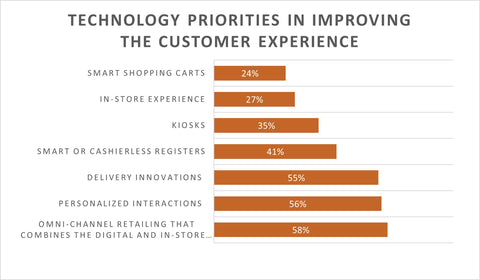The Retail industry has been flooded with competitors both in-store and online and leadership strategy comes down to one thing: customer experience. In fact, according to research from Metrigy, customer experience (CX) is the No.1 priority for retailers that are planning on increasing their technology spending in 2023.
“Research from PWC shows that 73% of consumers say CX is an important factor in their buying decisions, and 42% of people surveyed say they would pay more for a welcoming, friendly experience with a brand.”
WHAT ARE THE TANGIBLE BENEFITS?
With the spotlight on customer experience, what are the tangible benefits? Organizations that lead in customer experience outperformed laggards on the S&P index by nearly 80 percent, according to Qualtrics. These organizations also retain a higher share of wallets and have customers that are seven times more likely to return and purchase more from them. In addition, their customers are 15 times more likely to spread positive word of mouth. It’s no wonder then that customer experience is a priority for retail executives.
No matter the type of investment, all data points to the need to improve customer experience, which has a direct correlation to sales, margins, and returning shoppers. In this effort, 96 percent of retail executives believe that providing personalized and convenient retail experiences builds loyalty, and 95 percent of retailers are implementing or considering technology to improve customer experiences.
When asked about their technology investments to improve customer experiences, retail companies list the following as their priorities :

PERSONALIZATION IS KEY
Collecting consumer data can be extremely beneficial to a retailer as it can be used as a way to make the shopping experience more personalized for customers. And since consumers are 40% more likely to spend more than they planned when they have a personalized shopping experience, this can be extremely important for retailers to consider.

The consumer base is more diverse than it’s ever been. Between all the segments—who have different perspectives and savviness with technology—it’s hard to generalize assumptions and needs. While baby boomers may still prefer to interact with cashiers in a traditional store, Gen Xers may prefer a self-checkout experience. Millennials may prefer to do all their shopping online, whereas Gen Z may solely rely on social media for their purchasing needs.
The key to making retail media work inside the store is to make it valuable to consumers. People are apprehensive about targeted advertising but they love personalized service. There’s a disconnect between the two because the value proposition of targeted advertising isn’t entirely clear to them. This is where in-store technology can help.
Different technology solutions help provide customer data, which the retailer can then use to reach out to customers via email with personalized offers, and when going through the check-out process, retailers can search for the customer’s information to make their experience quick and efficient. Whichever way a retailer may use customer data to improve their experience, utilizing updated technology plays a significant role in that.
It is important to mention that retailers don’t need to leverage all of the technologies to deliver a memorable customer experience. The right mix depends on the retail business model. But with the generational diversity of the customer base, it makes sense that most organizations are focusing on technology that enhances a personalized customer experience.
Interested in learning how OnSite Media can help your company create a memorable in-store experience for your customers? Contact us today at 435-214-0801, ext. 1, or via email at sales@onsitemedia.com.




